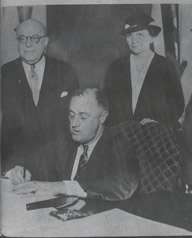United States Employment Service

The United States Employment Service (abbreviated as USES) is an agency of the United States government responsible for "assisting coordination of the State public employment services in providing labor exchange and job finding assistance to job seekers and employers". In around 1890, both the United States and European governments created the first federally funded employment offices. These offices were made to provide work for unskilled laborers that were unemployed. Due to the high number of economic depressions in the United States and Europe in the late 19th century and early 20th century in addition to high immigration rates to the United States, many people were unemployed, illiterate, and unskilled in terms of the workforce. These services proved to be unsuccessful and required more government interaction. Therefore in 1933, with the Wagner-Peyser Act, the USES was reinstated “to set minimum standards, develop uniform administrative and statistical procedures, publish employment information, and promote a system of "clearing labor" between states.”[1] The USES was helpful during the Great Depression, providing work for those that had lost their jobs. President Franklin D. Roosevelt had created many government funded work projects to help boost the economy during the Great Depression and the USES was responsible for hiring the workers on those projects. The USES operated originally in only a few states but by World War II, it was operating in all states and played a major role in providing jobs during the war. In the United States home front during World War II, the service coordinated employment of Prisoners of War (e.g., using German POWs at Gettysburg for local pulpwood cutting).[2]
Racism and World War II Employment
During World War II, many southern white men either joined the military or moved up North to find employment. As a kind of reverse migration however, southern black men chose to migrate south to rural Florida in hopes of finding work in agriculture. Many of the men traveling south sought work in the sugar company and were directed to the United States Employment Service (USES) for instruction. The main mission of the USES was to mediate the interactions between employers and potential-workers through the hiring process. Then in 1942 the Roosevelt administration federalized the USES and other departments involved in employment, however the USES remained a state-run organization for many of its activities.
Like many labor organizations of its time, the USES stated a belief in racial equality in the workplace, yet it provided fewer jobs for its African American workers. Historian Eric Arnesen from the University of Illinois argues that, “although the agency stated its general opposition to racial discrimination, it referred very few African Americans to jobs in war industries, defense training courses, or youth work-defense projects. In fact, the central administration encouraged its branches, especially in the South, to oblige employer preferences by accommodating racial discrimination.”[3] In the Bureau of Agricultural Economics instructional manual for the USES during wartime from the 1940s, it reads that the USES policy was, “to make all referrals without regard to race, color, creed, or national origin except when an employer’s order includes these specifications which the employer is not willing to eliminate,” and if the employer had no racial preferences “but community custom or past hiring practices of the employer indicate that he may refuse to hire individuals of a particular race, color, creed, or national origin, the employment office interviewer shall ascertain whether or not he has any restrictive specifications.”[4]
See also
References
| Wikimedia Commons has media related to United States Employment Service. |
- ↑ Gale Encyclopedia of US History: US Employment History
- ↑ "Staying at some camps wasn't fun and games". Good Ol' Days. January 12, 2007. Retrieved 2011-03-18.
- ↑ The Human Tradition in American Labor History, Written by Risa L. Goluboff Edited by Aric Arnesen
- ↑ Study 49, at 22, 23, Bureau of Agricultural Economics (BAE), Division of Program Surveys, Project Files, 1940-1945, National Archives, Record Group 83; Gunnar Myrdal et al., An American Dilemma: The Negro Problem and Modern Democracy (New York: Harper and Brothers, 1944), 417-18 (quoting instructional manual).